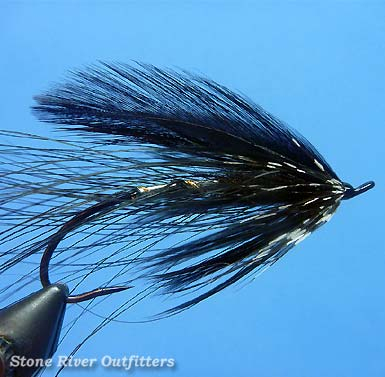
The Black Maheroney
A cross-pollination of Syd Glasso's classic Black Heron and Dec Hogan's signature Mahoney, this inspired hybrid has become not only my favorite fly to tie for steelhead on the swing, but also my most productive! From first pass on a fresh new pool, to working third in rotation behind a pair of skilled fishing friends, when I want to cover a run with complete confidence, this is THE pattern I reach for! Here's how we tie it.
Recipe / Materials List
- Hook: #1.5 Daiichi 2051 AJ Spey
- Thread: Danville's 6/0 Flymaster - Black and White
- Rear Body: #10 or #12 Flat Silver Mylar Tinsel
- Rib: Gold Medium Oval Uni French Tinsel
- Body Hackle: Black Goose Shoulder (burnt and split)
- Front Body: Black Standard SLF Dubbing
- Collar: Black Schlappen and Natural Guinea
- Wing: Black Strung Streamer Neck (or chinese neck)
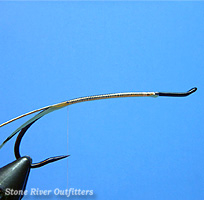 Step 1: Start your white tying thread just behind the tapered return loop eye, then affix your oval gold tinsel and flat mylar tinsel silver side down (i.e. silver side facing the hook). Next, carefully wrap your thread rearward towards the hook bend, smoothly binding the tinsels down as you go. Continue wrapping until you reach a stopping point located directly above the hook point, like shown.
Step 1: Start your white tying thread just behind the tapered return loop eye, then affix your oval gold tinsel and flat mylar tinsel silver side down (i.e. silver side facing the hook). Next, carefully wrap your thread rearward towards the hook bend, smoothly binding the tinsels down as you go. Continue wrapping until you reach a stopping point located directly above the hook point, like shown.
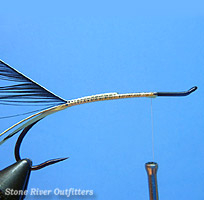 Step 2: Select a split, burnt Goose Shoulder feather (or similar long fibered "Spey" hackle) and tie it in butt first, on top of the hook shank. Once secured, advance your tying thread forward towards the hook eye, carefully binding the hackle stem down as you go, stopping approximately half way up the hook shank, like shown.
Step 2: Select a split, burnt Goose Shoulder feather (or similar long fibered "Spey" hackle) and tie it in butt first, on top of the hook shank. Once secured, advance your tying thread forward towards the hook eye, carefully binding the hackle stem down as you go, stopping approximately half way up the hook shank, like shown.
***Special Notes: An ambiguous term indeed, 'Spey' hackle can include almost any soft-flowing, long-fibered feather available. While popular options might include Heron (largely illegal), Blue Eared Pheasant (rare and pricey), Ringneck or Golden Pheasant Rump (length prohibitive), Schlappen (also length prohibitive) and more, I prefer fabricating my own 'Spey' hackles by splitting then burning inexpensive Goose Shoulder. Stay tuned for a future tutorial detailing how I prepare my split burnt goose!
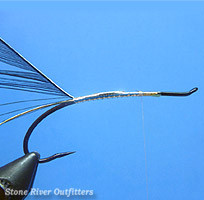 Step 3: Firmly grasp then wrap your flat mylar tinsel forward, with the silver side showing, in smooth level fashion until reaching your stopping point approximately half way up the hook shank. Tie the tinsel off with a few snug wraps of threads, then trim the excess tinsel away, like shown.
Step 3: Firmly grasp then wrap your flat mylar tinsel forward, with the silver side showing, in smooth level fashion until reaching your stopping point approximately half way up the hook shank. Tie the tinsel off with a few snug wraps of threads, then trim the excess tinsel away, like shown.
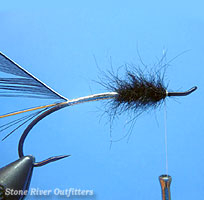 Step 4: Using black SLF Dubbing or a similar semi-coarse alternative like African Goat, build a moderately robust front-body section that spans the forward 1/3 of the hook's shank, like shown. Be sure while building this body that you do not crowd the tapered return loop eye!
Step 4: Using black SLF Dubbing or a similar semi-coarse alternative like African Goat, build a moderately robust front-body section that spans the forward 1/3 of the hook's shank, like shown. Be sure while building this body that you do not crowd the tapered return loop eye!
***Special Notes: Though the roll-dub method will no doubt work, I strongly recommend employing the Dubbing Loop method when building the front body of this fly! While the roll-dub method is indeed fast and easy, it kills the coarse, shaggy appearance that spikey dubbings like SLF or Goat yields. The dubbed loop method however, enhances it.
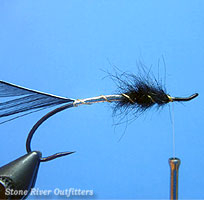 Step 5: Once the dubbed front is complete, firmly grasp your oval gold tinsel and wrap it forward along the hook shank, creating a tightly wound rib of 5 or so steeply angled and evenly spaced turns. Tie the oval tinsel off securely, then trim the excess tinsel neatly away.
Step 5: Once the dubbed front is complete, firmly grasp your oval gold tinsel and wrap it forward along the hook shank, creating a tightly wound rib of 5 or so steeply angled and evenly spaced turns. Tie the oval tinsel off securely, then trim the excess tinsel neatly away.
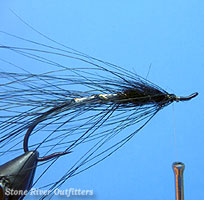 Step 6: Grasping the split, burnt goose shoulder feather by its tip, carefully wrap the 'Spey' hackle forward, closely chasing the rear edge of your gold oval tinsel rib with tightly abutting turns. Snugly tie the hackle off closely in front of your dubbed body, then trim the excess hackle away neatly at its base.
Step 6: Grasping the split, burnt goose shoulder feather by its tip, carefully wrap the 'Spey' hackle forward, closely chasing the rear edge of your gold oval tinsel rib with tightly abutting turns. Snugly tie the hackle off closely in front of your dubbed body, then trim the excess hackle away neatly at its base.
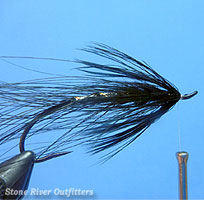 Step 7: Select a prime and slightly oversized black Schlappen feather and tie it in snugly towards its tip, curved side down. Gently fold the feather's fibers rearward then take two or three turns with the black Schlappen to create a sparse but noticeable under-collar. Once satisfied, tie the Schlappen off using a couple well-placed wraps of thread, then trim the excess feather away neatly, like shown.
Step 7: Select a prime and slightly oversized black Schlappen feather and tie it in snugly towards its tip, curved side down. Gently fold the feather's fibers rearward then take two or three turns with the black Schlappen to create a sparse but noticeable under-collar. Once satisfied, tie the Schlappen off using a couple well-placed wraps of thread, then trim the excess feather away neatly, like shown.
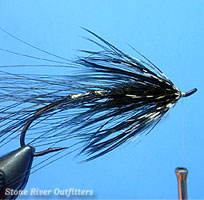 Step 8: Select a prime, slightly oversized and nicely spotted Natural Guinea feather and tie it in firmly by its tip, curved side down, bold spots facing out. Pinch fold the Guinea's fibers rearward then take two or three turns with the feather to create a handsome fore-collar. Once wrapped, snugly tie the Guinea off with a couple turns of thread, then trim the excess feather neatly away, like shown.
Step 8: Select a prime, slightly oversized and nicely spotted Natural Guinea feather and tie it in firmly by its tip, curved side down, bold spots facing out. Pinch fold the Guinea's fibers rearward then take two or three turns with the feather to create a handsome fore-collar. Once wrapped, snugly tie the Guinea off with a couple turns of thread, then trim the excess feather neatly away, like shown.
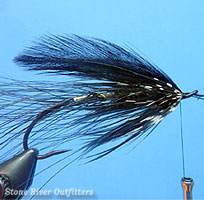 Step 9: Whip finish then trim your white tying thread and restart with black. Carefully select 2 left-matching and 2 right-matching black Strung Streamer Neck feathers. Neatly pair the 2 matching feather sets together in clasping fashion to create a single knife-like wing, then carefully mount that wing in place directly on top of, and directly in-line with the hook shank using a few well-placed, snugly drawn wraps of thread.
Step 9: Whip finish then trim your white tying thread and restart with black. Carefully select 2 left-matching and 2 right-matching black Strung Streamer Neck feathers. Neatly pair the 2 matching feather sets together in clasping fashion to create a single knife-like wing, then carefully mount that wing in place directly on top of, and directly in-line with the hook shank using a few well-placed, snugly drawn wraps of thread.
***Special Notes: The up-turned loop eye on most traditionally styled salmon/steelhead irons makes mounting knife-like featherwings fast, fun, and easy using the 'stem-through' method. For an exceptional video illustration of this handy technique in action, be sure to check out Dec Hogan and Marty Howard's awesome instructional DVD titled Steelhead Flies Tying Classics
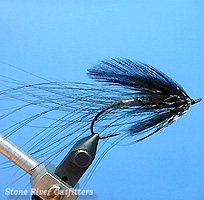 Step 10: With the wing securely set, carefully trim the excess feather stems away cleanly at their base and build a nice, even, neatly tapered head with your black thread. Whip finish, trim, and apply a smooth level coat of glossy head finish to your completed wraps.
Step 10: With the wing securely set, carefully trim the excess feather stems away cleanly at their base and build a nice, even, neatly tapered head with your black thread. Whip finish, trim, and apply a smooth level coat of glossy head finish to your completed wraps.
Summary / Closing Remarks: Well friends, there we have it! An inspired hybridized-cross featuring two widely-recognized and much-beloved favorites from a pair of true gentlemen-legends whose names and flies are synonymous with Pacific Northwest steelhead on the swing... I hope you'll find the Black Maheroney as fun and rewarding a fly to both tie and fish, as I have. As always, have fun with this one gang. Thanks so very much for all your support, and please don't hesitate to call on us if we can be of further assistance! Sincerely - Nate Harris
